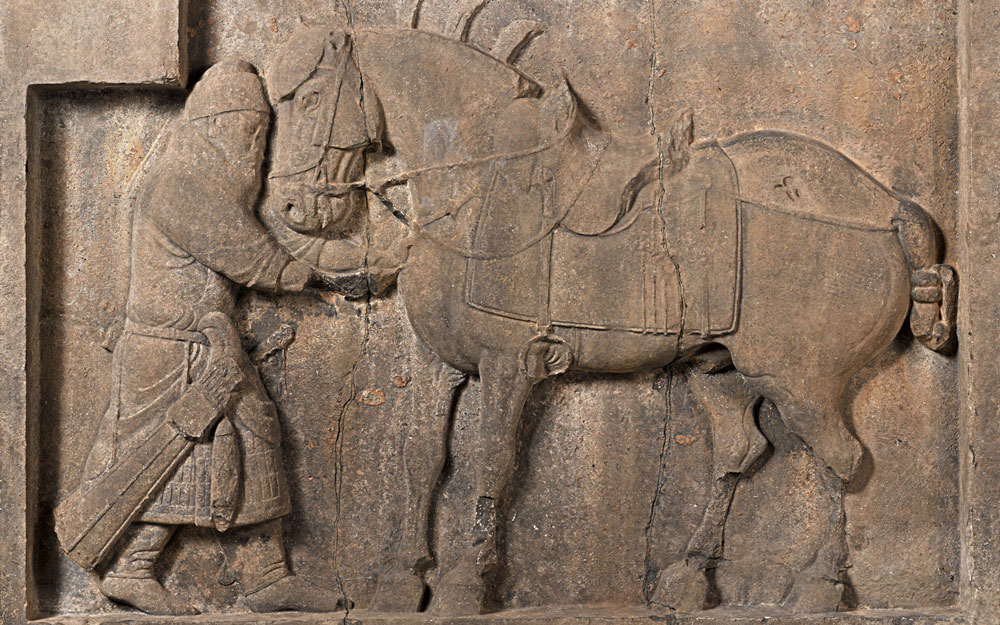Asia
Marvel at one of the finest collections of monumental Asian art showcased in the architecturally stunning 90-foot tall Rotunda.
Upper Level
Included with Museum Admission
Above: Statue of Guanyin, China, C443

Marvel at one of the finest collections of monumental Asian art showcased in the architecturally stunning 90-foot tall Rotunda.
Upper Level
Included with Museum Admission
Above: Statue of Guanyin, China, C443

From wondrous winged lions to stunning stone carvings, explore early Asian artistic traditions and trace the early development of Buddhism.
Above: Statue of Guanyin, China, C443
Trace the history of Buddhist art: Early depictions of the life of the Buddha on reliquaries from Gandhara, stone statues of bodhisattvas carved during the height of Buddhism in medieval north China, and Japanese images in materials like stone, wood, glazed ceramic, and lacquer. Monumental winged lions represent the beginnings of stone sculpture in East Asia to stand guard over grand tombs. The most famous examples of tomb sculpture in the gallery are the two horses, Saluzi and Quanmaogua, from the tomb of the Tang Emperor Taizong. Other unique treasures include ancient bronze vessels, jade ceremonial blades, the silver Khitan death mask, and the stunning crystal sphere, one of the world’s largest, fashioned from a massive Burmese crystal in 1920s Shanghai.





After consolidating the Tang Empire, Emperor Taizong ordered six large stone panels to be carved with the portraits of his favorite horses. These were the horses he had ridden in overcoming his rivals and securing the territory of the empire. From the laudatory poem he composed for each horse, the names and attributes of the horses can be matched to the stone reliefs. The relief shown here depicts the horse called Saluzi, ridden by Taizong at the battle for the city of Luoyang, the Eastern Capital, in 621 CE. When the horse was stuck with an arrow, the emperor was forced to dismount and switch horses with his general, Qiu Xinggong. The general is shown in the relief pulling the arrow out of the horse's chest while it stoically bears the pain. C395
Gilt-bronze statuette of Maitreya. The statue is in typical Eastern Wei style, standing with flowing robes and hands adopting the gestures (mudrās) 'fear-not' and 'charity offering'. A fiery aureole with a lotus halo is attached at the back of the figure with a pair of pins. The figure stands on a domed lotus, above a four-legged square base. On two sides of the base is an incised inscription recording the date (equivalent to April 9th, 536 CE) and location of manufacture (in Dingzhou 定州, in modern Henan), together with a list of subscribers. C355.1
Fudo is a wrathful deity depicted in Japanese Buddhist art with a fierce expression and flames around his body, symbolizing his ability to burn away obstacles toward enlightenment. Fudō “The Immovable” is a translation of his Sanskrit name, Acala, and represents his steadfast dedication to the Buddhist faith. He often appears as a supporter of the Buddha Vairocana. 29-96-346
This carved fragment was part of a stone Buddhist stupa (reliquary mound) positioned so that worshippers who came to honor the Buddha would see the events of his life and learn of his spiritual accomplishments. The bottom depicts the 'great passing away' of the Buddha from his earthly existence. Lying on a bed, he is surrounded by his disciples who express the tremendous anguish they feel at the loss of their spiritual leader. 29-64-223
Adam Smith, Ph.D, and C. Brian Rose, Ph.D. share the iconography of hybrid creatures, especially winged lions. Winged Lion imagery traveled through the Mediterranean and into China by way of the Silk Road and can be found at burial sites.

At the Museum | January 27, 2024
The Penn Museum has hosted an event in celebration of Lunar New Year annually since 1981. An important festival in many Asian countries, our celebration is a family-friendly event filled with live performance, storytelling, and a traditional Lion Dance. Save the date to ring in the Year of the Dragon with us!

Lecture
Anne Brownlee, Ph.D., Associate Curator
The architecturally stunning Rotunda, 90 feet in both diameter and height, has been home to the Museum’s display of Asian art since it was built more than a century ago. Its story begins in the 1890s, when the Museum turned to a talented team of Philadelphia's young "Queen Anne" superstars—Wilson Eyre, Frank Miles Day, Walter Cope, and John Stewardson—to create a master plan and begin construction of a vast new building that could never be filled and was never finished.